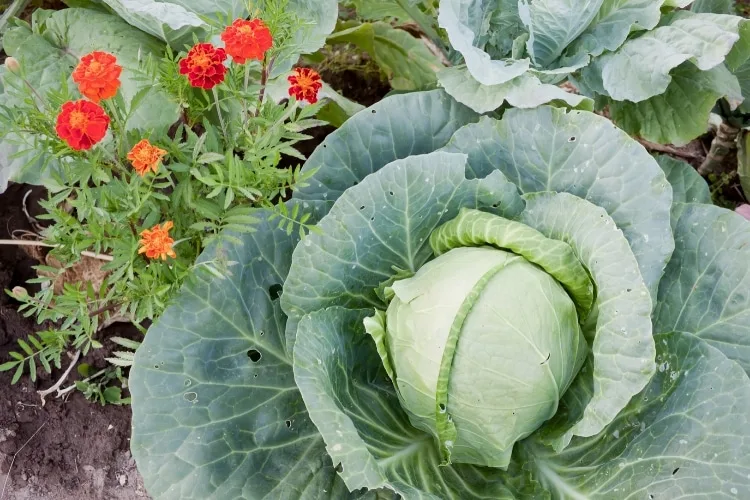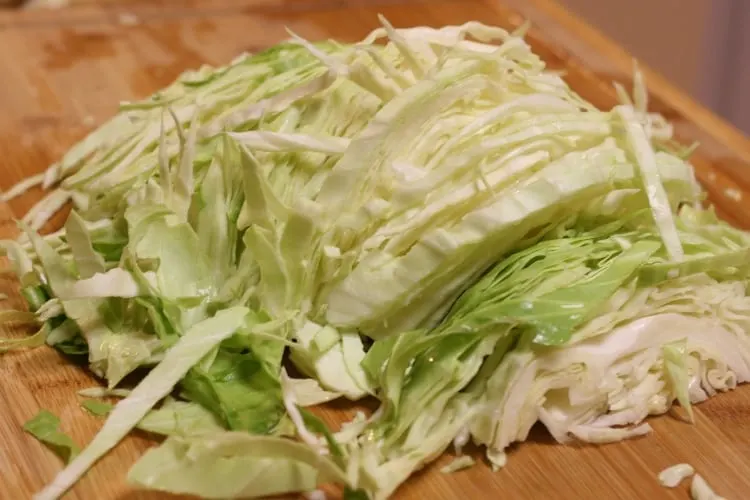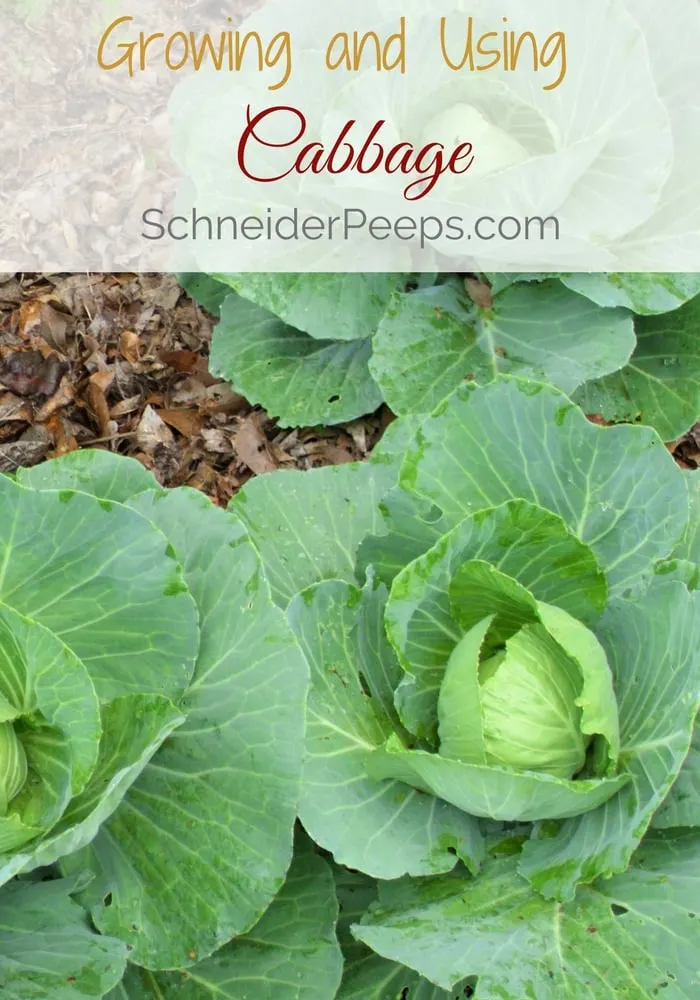
Cabbage is a staple in our kitchen during the winter and early spring, it’s probably our favorite winter vegetable. Every year we grow enough cabbage to eat fresh and preserve some for the summer. Growing cabbage in the home vegetable garden is relatively easy and a great way to have greens all winter long.
Cabbage is a member of the Mustard family, more specifically it’s categorized as a brassica along with broccoli, Brussels sprouts, cauliflower, and kale. All of these vegetables are cool weather crops and are highly nutritious.
For cabbage that develops a head, you’ll get just one harvest per plant but for cabbages that are loose leaf you can harvest a few leaves at a time. I keep a set of worksheets to track how much I need to plant each year to feed my family. You can get a copy of these worksheets emailed to you by filling out the form below.

How to Plant Cabbage
There are two ways to plant cabbage – sow seeds directly in the garden or plant transplants (ones you’ve bought or started indoors.) I usually do both.
For spring gardens, direct sow seeds about two weeks before average last frost. If starting indoors, sow seeds in seedlings trays or small pots four to six weeks before average last frost. You can plant the transplants in the garden just before the average last frost.
Cabbage loves cool weather so it shouldn’t be harmed by a late light frost. The edges of the outer leaves might get burned but the cabbage will be fine.
If you live in a climate that has a short spring – it goes from winter weather to hot weather very quickly – plant varieties that have have a short maturity date.
For fall/winter gardens sow cabbage seeds 8-10 weeks before average first frost. Plant transplants 6-8 weeks before average first frost. Cabbages are frost tolerant plants so don’t worry about harvesting them all before the first frost.
If you live in an area with a mild winter, you can grow cabbage all winter long. I usually plant cabbage transplants in late September or early October. When I plant them, I direct sow some seeds too. This is my lazy way of succession planting and ensures that not all the cabbages are ready at the same time.
Sow cabbage seeds about 1/2″ deep. Depending on the cabbage variety, cabbage will need 24″-36″ of space between heads. Since I garden in raised beds, I like to off set my rows to squeeze three rows in a 4’x8′ garden bed.
Cabbage plants are heavy feeders that like rich, well draining soil.
Growing Cabbage
After sowing seeds or planting transplants, water the cabbage regularly. This is hard for me once the cooler temperatures come but it’s important to do. Cabbage likes consistent water, not a flooding then a drying out. If it doesn’t rain, water at least once a week.
Cabbage will do better if you top dress with some compost after growing about 4-6 weeks. This will give the cabbage the nutrition it needs to make a good full head.
Once the temperatures reach the upper 80s cabbage will get bitter.

Cabbage Varieties
There are many varieties of cabbage. The colors range from light green (almost white) to deep green and even purple. While most of us think of head cabbage when we think of cabbage there are also leaf cabbage varieties.
Days to maturity can range from 55 days to over 100 days. Planting a variety of cabbages with different days to maturity is a great way to have cabbage all seasonal long.
Early season cabbage varieties mature in less than 70 days and include Copenhagen Market, Savoy Express, Gonzalez, and Red Acre. All of these produce fairly small heads. Savoy Express has fun crinkly leaves and Red Acre is a red variety.
Specialty cabbages such as Pak Choi and Napa are also early cabbage varieties.
Mid-season cabbage varieties mature in 70-90 days and include varieties such as Primero and Mammoth Red Rock. Both of these produce round heads, Primero is green and Mammoth Red Rock is red. Savoy Perfection is a savoy mid-season variety.
Late season cabbage varieties mature in 90-120 days and are usually very large plants. Late varieties also tend to store better than early or mid-season varieties. Some late season varieties are Late Flat Dutch, January King, and Danish Ballhead.
Many of these seeds can be found at MiGardener Seed Company. MiGardener sells heirloom seeds for just $2 a packet. You can get a 10% discount on your order by using this link.
Problems and Pests of Growing Cabbage
For the most part cabbage is pretty easy to grow. splashing-not the plant in order to not splash dirt down into the cabbage head. This will make it easier to clean when you harvest.
Cabbages can attract aphids, leaf beetles, cabbage moths, slugs, and black rot. Companion planting with dill to attract ladybugs can help with the aphids.
Since cabbage doesn’t need pollination, growing cabbage under row covers can help with leaf beetles and cabbage moths. Just be sure to put the row cover on early before the leaf beetles and cabbage moths find the cabbage or you’ll trap them in. They won’t care but it won’t be good for your cabbage.
Black rot can be controlled by rotating crops and not watering the leaves. Here’s a good article from Cornell on managing black rot.

Harvesting and Storing Cabbage
You can harvest head cabbage after the head has formed and filled out, gently squeeze the head to make sure it’s firm. You can harvest the outer leaves whenever you want to. They aren’t as tasty as the tender inner leaves but still good. I like to harvest a few and saute them with cauliflower and broccoli leaves early in the season as a secondary harvest.
In mild winter climates, you can let the cabbage stay in the ground all winter and just harvest as needed. In colder climates, you can grow cabbage during the winter under frost row tunnels and the snow will insulate the tunnels.
To harvest a cabbage, cut the head off at the base. There will probably be some outer leaves that don’t get cut. Some cabbage varieties will produce a few baby heads once the large head is cut off, so it’s okay to just leave the plant in the ground.
Once the head is harvested, I will usually cut remove the outer leaves, and chop and drop them for mulch; if they don’t have pests or diseases on them.
Cabbage can be stored in the root cellar for several months. I don’t have a root cellar so I’m no help here, but Homestead Honey does and stores quite a bit in it. Here are her root cellar tips.
Cabbage can also be stored for a few weeks in the refrigerator by putting it in plastic bag that’s not sealed but has some moisture in it.
What to do with cabbage
Cabbage is pretty versatile and can be cooked in soups, such as this potato cabbage soup, or stuffed and rolled into cabbage rolls.
It can also be eaten raw in cole slaw. My family doesn’t care much for cole slaw but I really like it. There are two main types of cole slaw, mayonnaise cole slaw and no-mayo cole slaw. But you can also make a slaw with pomegranate in it – which sounds amazing.
One of the best ways to preserve cabbage for the year is to make sauerkraut, it’s super easy and really good for you.

If you have other tips for growing cabbage, feel free to leave them in the comments.

Beth
Wednesday 21st of March 2012
A great start to Spring! We have snow on the ground this morning, so the garden will have to wait.
Athena at Minerva's Garden
Tuesday 20th of March 2012
Your plant starts look wonderful, and I envy your ability to grow such handsome cabbage! We are plagued with cabbage moths here, and about the only way I could grow it in my garden is to cover it through its entire growth cycle with row cover, for which I have not found an inexpensive source. I sometimes do a bit of kale, another brassica, under plastic in the fall, and that does survive unharmed, because the moths are dead and gone by that time of the year.
CAPERNIUS
Sunday 30th of March 2014
OK, I'll admit to being ignorant* to planting/growing cabbage.
How big, or how small, are cabbage moths? I ask because I'm wondering why you could not build a frame of PVC pipe around the cabbage(or the whole garden for that matter) and then cover this frame with hardware cloth, and/or, fibreglass window screening...
The cabbage would get all the sunlight & rain they need, but the pests would not be able to get in...
Not trying to tell you what to do, just an idea you might be interested in.
*Ignorant = without knowledge.
Stupidity = you have the knowledge, you just choose not to use it.
Rachel E.
Tuesday 20th of March 2012
Thanks for your info! I look forward to trying all these wonderful things out.
Unfortunately, we won't be able to have chickens. I was so disappointed to find this out. Evidently, our county doesn't like chickens very much so they give really strict rules for poultry. Our property size is not in the correct dimensions to have a hen house or pen with correct distance from all property lines. My husband says we should raise rabbits for food! I am not sure. I have to think on that one.
SchneiderPeeps
Tuesday 20th of March 2012
bt is an organic "insecticide" that only kills caterpillars. It's a bacteria that makes the caterpillar not hungery and so he stops eating. I don't use it alot, but I do use it occassionally on cabbage and broccoli. I also used the liquid version during our war on the vine borers on our squash last year. It worked well.
We keep a pile of leaves, you can also add kitchen scraps but we give those to the hens. We also put leaves in our chicken run for the hens to scratch up. We don't collect our grass clippings, we just leave them on the ground. The key with compost is to get it hot. If it reaches 160 degrees as it breaks down then (theoretically) it will kill all the seeds. That's why grass clippings are ok in it. I personally don't worry to much about how much brown and how much green to put on the pile. I just try to keep it moist and turn it occassionally. Any organic matter will break down over time, it will just be faster if you have a mix of green and brown. Also, your chickens will be a good help with this.
We have grown corn successfully, but we won't be growing it this year. It takes a lot of space and each stalk only gives you one, maybe two, ears. And I can buy local corn here in the summer 10 ears for $1. Probably the biggest tip is that after the plant is pollinated - the tassels will begin to wilt - put some mineral oil on them to keep out the worms. I have a page on corn from last summer in the garden section.
Rachel E.
Tuesday 20th of March 2012
I agree, your cabbage looks wonderful and pretty. How fun! I am curious what bt is. Have you grown corn with success? Also, what can you tell me about composting? What do you compost? I plan to start composting as soon as we get moved. Do you put grass clippings in your compost? I don't want to pull a ton of weeds from the garden, but I have heard that you really need leaves and grass in your compost to make a good one.